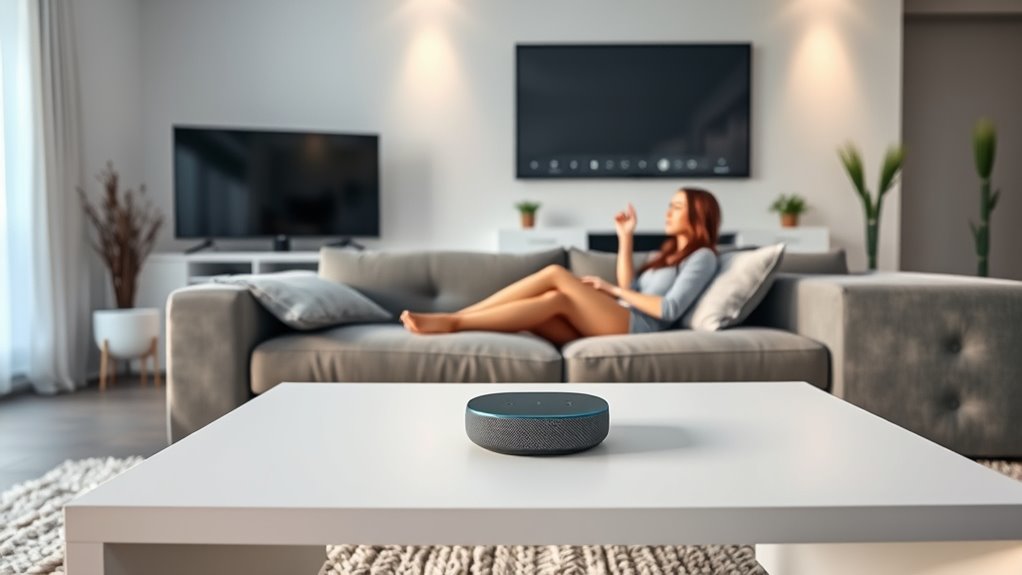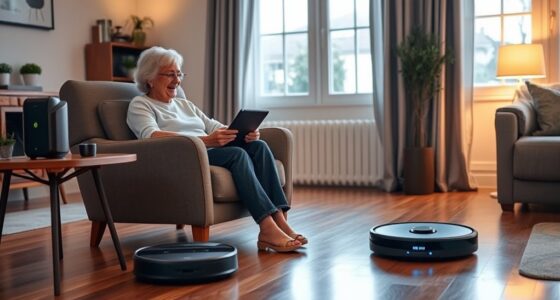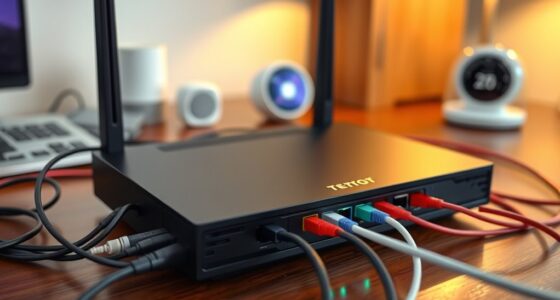Voice-activated assistants make managing your home easier by allowing you to control lights, thermostats, and security with simple spoken commands. They use artificial intelligence to understand natural language and work seamlessly within various ecosystems like Alexa, Google, or Siri. With features like voice recognition, smart speakers, and automation routines, you can customize your experience for convenience and security. If you want to learn how to optimize your setup, there’s more to discover below.
Key Takeaways
- Choose a voice assistant compatible with your smart home devices, such as Amazon Alexa, Google Assistant, or Apple Siri.
- Use natural language commands and specific device names for more accurate and effortless control.
- Ensure your devices are positioned centrally to maximize microphone pickup and recognition reliability.
- Keep software updated to improve recognition accuracy, security, and compatibility with new devices.
- Incorporate routines and scenes for automated, hands-free control of multiple smart home functions.
Understanding How Voice Assistants Enhance Home Management
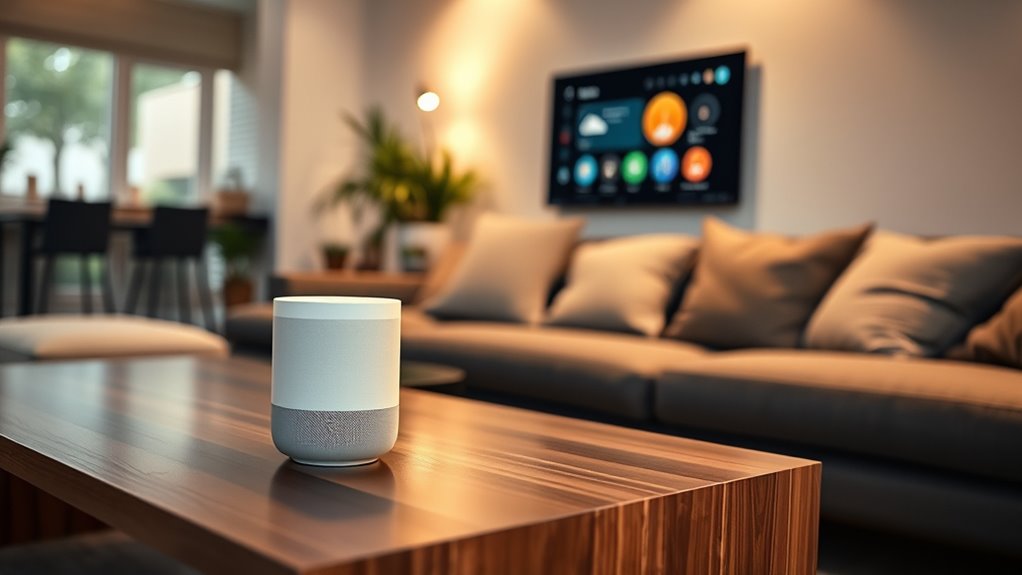
Voice assistants make managing your home simpler by using artificial intelligence to understand and respond to your spoken commands. With voice control, you can operate smart home devices effortlessly, from lights to thermostats, just by speaking. These devices often support natural language processing, allowing for more conversational interactions. Many support controlling multiple devices at once, making complex home management tasks easier. They seamlessly integrate with ecosystems like Amazon Alexa, Google Assistant, or Apple Siri, ensuring smooth operation across compatible devices. Natural language processing allows you to speak conversationally, so managing your home feels intuitive and accessible for everyone. Additionally, these systems can utilize voice recognition, enhancing security and personalized control by identifying individual users. This technology transforms home management into a hands-free, efficient experience, especially when used in smart home environments. Moreover, ongoing advancements in AI technology continually improve the responsiveness and capabilities of voice assistants, making them an even more integral part of modern home management.
Exploring the Top Voice Assistants of 2024
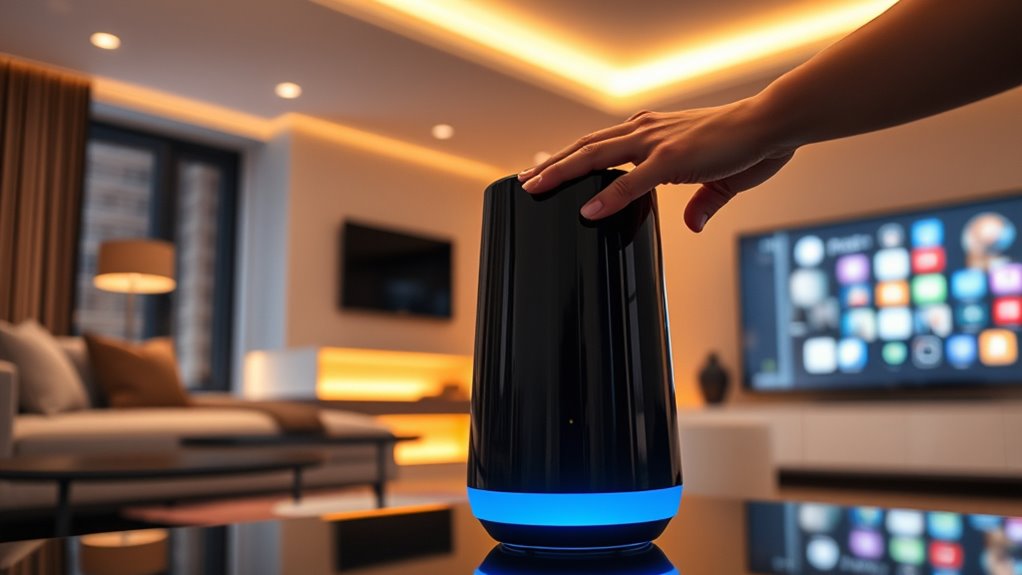
In 2024, the landscape of voice assistants remains dominated by Amazon Alexa, Google Assistant, and Apple Siri, each offering unique features tailored to different user needs. If you’re building a smart home, your choice depends on device compatibility and privacy preferences.
- Amazon Alexa provides over 100,000 skills and works with thousands of smart home products, making it highly versatile. Its extensive compatibility allows for a customizable smart home experience. Industry trends show that AI-driven solutions are increasingly integrated into everyday devices, enhancing user convenience.
- Google Assistant excels in voice recognition and integrates seamlessly with Google services and smart displays. Its ability to understand natural language enhances user interaction. Its natural language processing capabilities continue to improve, making conversations more intuitive.
- Siri, mainly on Apple devices like HomePod Mini and iPhones, emphasizes strong privacy but has limited third-party compatibility. Its integration within the Apple ecosystem ensures a secure user environment. Privacy policies are a key factor influencing user trust and adoption.
Your decision hinges on your ecosystem and what you value most in device integration. Additionally, understanding the Gold IRA landscape can help safeguard your investments in the long run. It’s also important to consider privacy policies and how each assistant manages user data to make an informed choice. Each voice assistant offers distinct advantages, ensuring you find the right fit for effortless smart home control.
Features and Capabilities of Leading Smart Speakers
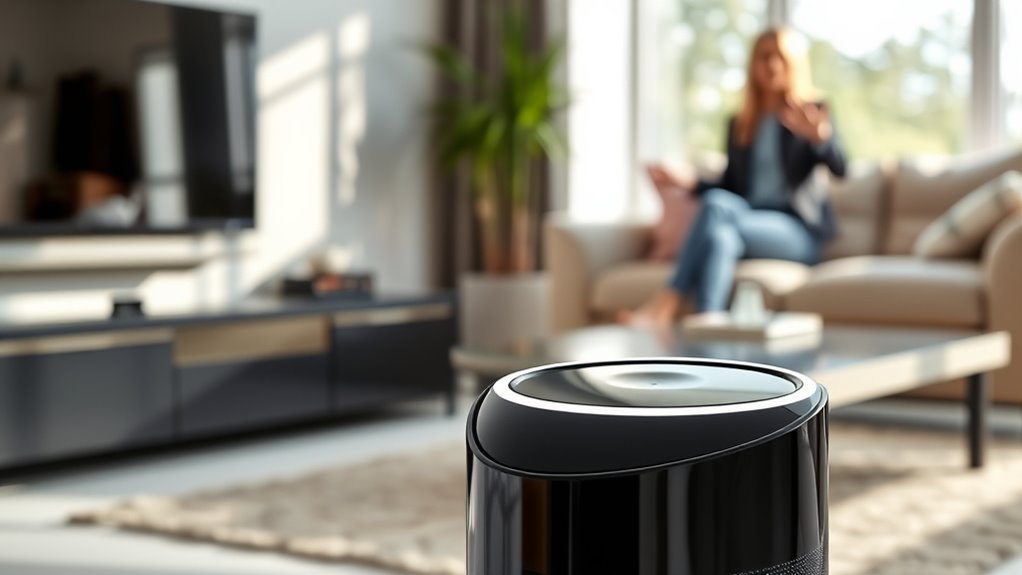
Leading smart speakers deliver impressive sound quality and volume, filling your space with rich, clear audio. They also seamlessly integrate with your smart home devices, allowing you to control lights, thermostats, and more with simple commands. A new feature includes diverse design options, enabling you to choose devices that match your decor and style preferences. With features like multiroom audio and support for various streaming services, these devices enhance your listening experience and home automation effortlessly. Additionally, many models support voice recognition, allowing multiple users to access personalized settings and preferences easily. These devices can also be compatible with essential oils to create a calming environment through aromatherapy. Recognizing the importance of father-daughter bonds, some smart speakers offer personalized interaction profiles to strengthen family connections and shared experiences. Furthermore, integrating power management capabilities helps optimize energy use and prolong device lifespan.
Sound Quality and Volume
Have you noticed how some smart speakers deliver remarkably rich and clear sound despite their compact size? Leading smart speakers like the Sonos Era 300 and Amazon Echo Studio excel in sound quality, offering immersive audio with deep bass, crisp highs, and balanced mids. They support features like Dolby Atmos and multi-channel setups for a cinematic experience. Volume control is precise and easy to manage through voice commands, physical buttons, or apps, ensuring you can adjust sound levels effortlessly. Additionally, sound quality can vary based on speaker design and technology, influencing your overall listening experience. The technology behind audio performance plays a crucial role in achieving these high standards. Effective speaker design and advanced audio processing enhance the sound clarity, making the listening experience more enjoyable. Just as literature uses vivid natural imagery to evoke emotions, the design of these speakers employs sophisticated acoustic engineering to create an immersive auditory environment.
Smart Home Integration
Smart speakers seamlessly connect to a wide range of smart home devices, allowing you to control lights, thermostats, security systems, and more with simple voice commands or through dedicated apps. With strong smart home integration, your devices become more responsive and easy to manage. Additionally, many devices support safety features that help prevent accidental or unsafe operation, making your smart home environment more secure. Leading speakers like Sonos Era 100, Amazon Echo, and Google Nest Audio support multiple ecosystems—Amazon Alexa, Google Assistant, and Apple HomeKit—ensuring compatibility with a broad selection of smart devices. You can activate routines or scenes, such as “Good Morning” or “Good Night,” to control multiple devices at once. Advanced features like room calibration and multiroom audio further enhance your experience, making your smart home more intuitive and personalized. These capabilities give you effortless control and seamless automation, especially when integrated with smart home market growth strategies to expand your system. Leveraging AI content clustering can help optimize your smart home device management and automation workflows, ensuring more efficient and intelligent control. Furthermore, ongoing advancements in smart speaker technology are making these devices even more capable and versatile, adapting to the evolving smart home ecosystem and user needs.
Choosing the Right Voice Assistant for Your Needs
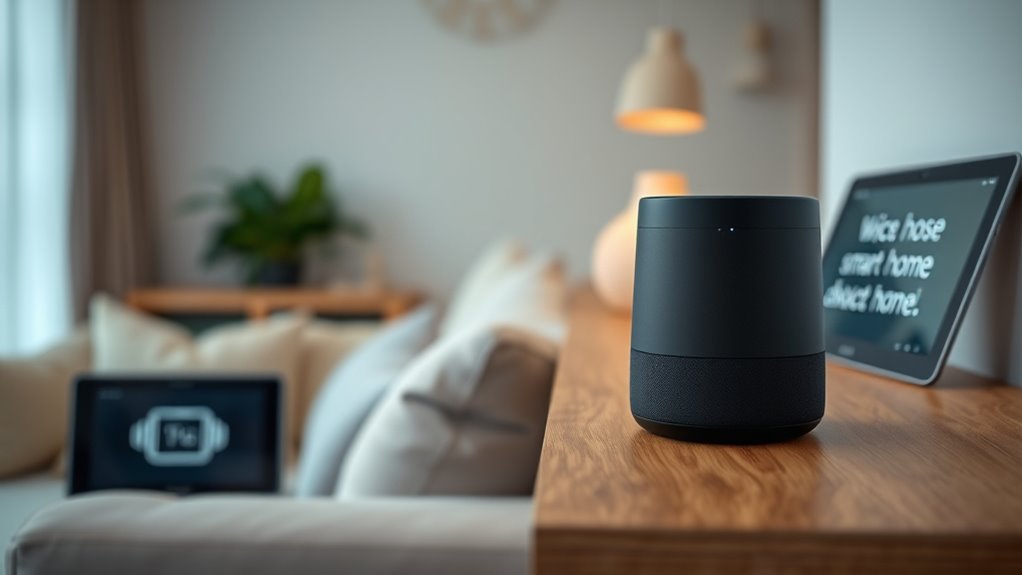
When choosing a voice assistant, think about your device ecosystem—Siri works best with Apple devices, while Google Assistant fits seamlessly with Google services. Consider how well the assistant connects to your smart home gadgets and the features you need. Also, evaluate privacy policies to find a system that aligns with your security preferences. For automotive enthusiasts, Ford Tuning options can be integrated with voice assistants to allow hands-free control of vehicle settings and performance adjustments. Additionally, understanding the security measures implemented by these systems can help you better protect your personal data in the age of AI. Moreover, considering the market volatility and diversification strategies such as converting your 401k to a Gold IRA can also inform your overall approach to secure and efficient financial management.
Ecosystem Compatibility Options
Choosing the right voice assistant hinges on your existing ecosystem, as seamless device integration depends on compatibility. Your choice should align with your preferred ecosystem options—Apple, Google, or Amazon—to ensure smooth operation.
If you’re invested in Apple products, Siri offers strong ecosystem compatibility within the Apple environment, but it may limit smart home device integration with third-party gadgets.
For Google users, Google Assistant provides excellent compatibility with Google services and smart devices, making setup straightforward.
Amazon Alexa supports the broadest range of smart home devices and skills, giving you extensive customization options.
Consider your hardware preferences, like HomePod, Nest, or Echo, to make sure your device integration is seamless and performance is optimized within your chosen ecosystem.
Privacy and Security Measures
Are you aware of how your voice assistant’s privacy and security features impact your personal data? Choosing a device with strong privacy settings is vital. Look for options to disable data collection or voice recordings, which enhances data security.
Devices that support local processing of commands reduce reliance on cloud services, lowering the risk of data exposure. Regular firmware updates are essential; they ensure security patches are applied and vulnerabilities fixed.
Clear user controls and transparent privacy policies let you manage permissions and data sharing effectively. Additionally, securing your Wi-Fi with strong, unique passwords and enabling two-factor authentication adds an extra layer of protection.
Prioritizing these privacy and security measures helps safeguard your personal information while enjoying the convenience of voice-activated assistants.
Integrating Voice Commands With Smart Home Devices
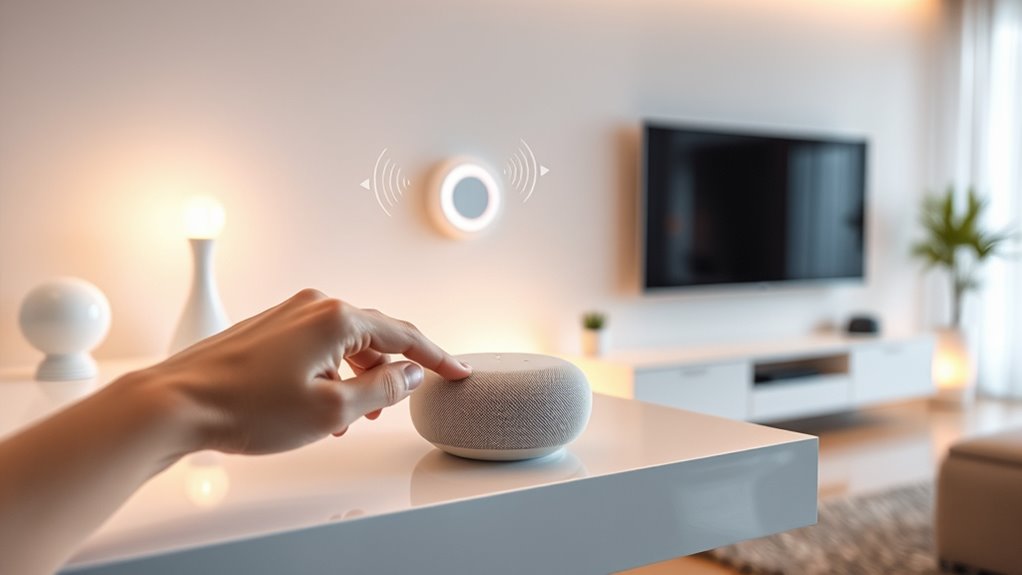
Integrating voice commands with smart home devices allows you to control multiple systems effortlessly through compatible ecosystems like Amazon Alexa, Google Assistant, or Apple HomeKit. These platforms support a variety of smart home devices, enabling you to create seamless routines and scenes.
Control multiple smart home devices effortlessly with voice commands on Alexa, Google Assistant, or Apple HomeKit.
With voice commands, you can activate multiple devices at once, such as turning off lights, adjusting the thermostat, and locking doors. Natural language recognition lets you issue complex commands, like “Good morning,” to trigger several actions.
You can also set up routine automation so a single command handles multiple tasks. This hands-free control makes managing your home easy and accessible for everyone.
- Control multiple devices simultaneously
- Use natural language for complex commands
- Automate routines for convenience
Tips for Optimizing Your Voice-Controlled Home Environment
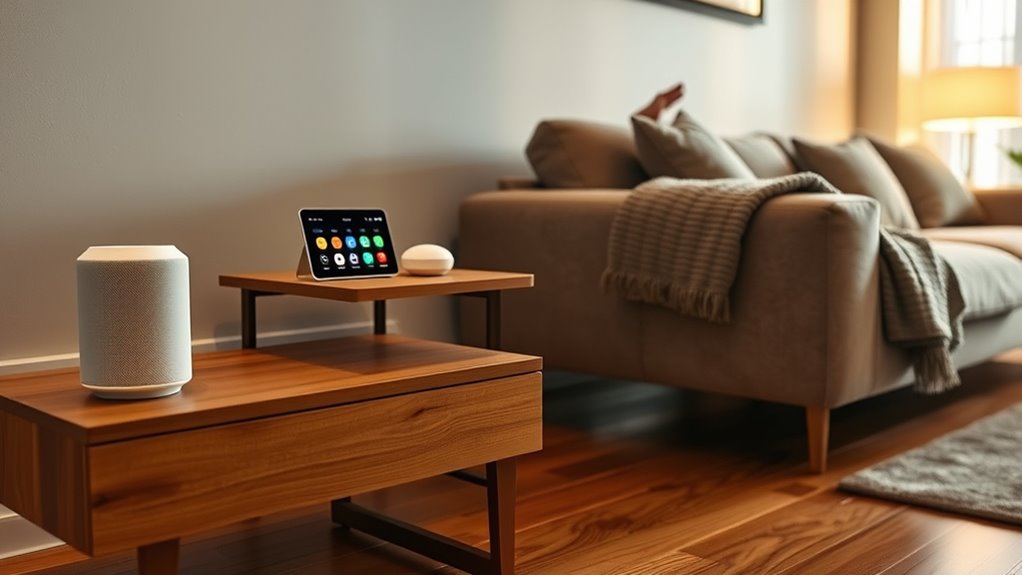
To get the most out of your voice-controlled home, start by creating personalized routines and scenes, like “Good Morning” or “Good Night,” that automate multiple devices at once. This enhances home automation and simplifies daily tasks.
Make sure your voice recognition works smoothly by properly linking your voice assistant and compatible smart devices in the app. Regular software updates for both your devices and voice assistant improve recognition accuracy and device integration.
Use clear, natural language commands with specific device names or group labels to avoid confusion and boost responsiveness.
Position your voice-enabled devices in central locations to maximize microphone pickup, ensuring reliable voice recognition throughout your home.
These steps help optimize your environment for seamless control and better interaction with your smart devices.
Frequently Asked Questions
What Is the Best Voice Control Assistant?
When choosing the best voice control assistant, you need to take into account your device ecosystem and what features matter most to you.
If you want accuracy and multi-language support, Google Assistant is a great pick.
For smart home integration and third-party skills, Alexa excels.
If you’re deeply embedded in Apple devices, Siri offers seamless compatibility.
Think about your devices, privacy, and what you want to control to find the perfect fit.
What Are the Top 3 Voice Assistants?
You’re curious about the top three voice assistants, and here they are: Amazon Alexa, Google Assistant, and Apple’s Siri.
Alexa offers a vast skill library and broad device compatibility, making it versatile.
Google Assistant shines in accuracy and contextual understanding, especially within its ecosystem.
Siri seamlessly integrates with Apple products, providing convenience for Apple users.
Each has strengths, so your choice depends on your device ecosystem, needs, and preferences.
Can a Home Assistant Be Controlled by Voice?
Yes, you can control a home assistant by voice. When you say the trigger words like “Hey Siri,” “Alexa,” or “OK Google,” the device listens and responds to your commands.
You can ask it to adjust smart home devices, play music, or get information. Just make sure your microphone is enabled, and privacy settings are configured to suit your preferences for a seamless, hands-free experience.
What Is a Voice Control Assistant?
A voice control assistant is a smart device that listens for your spoken commands to help you manage tasks hands-free. It activates with trigger words like “Hey Siri” or “Alexa,” and it responds using natural language processing.
It can control your smart home devices, answer questions, play media, or perform internet searches, making everyday activities more convenient and effortless.
Conclusion
Embracing voice-activated assistants transforms your home into a seamless symphony of convenience, where every command flows effortlessly like a well-orchestrated melody. By choosing the right device and optimizing its capabilities, you access a world where technology anticipates your needs and simplifies your daily routines. Remember, in the quiet hum of these smart assistants lies the power to turn your house into a truly intelligent home—waiting patiently to serve you at a whisper’s notice.
